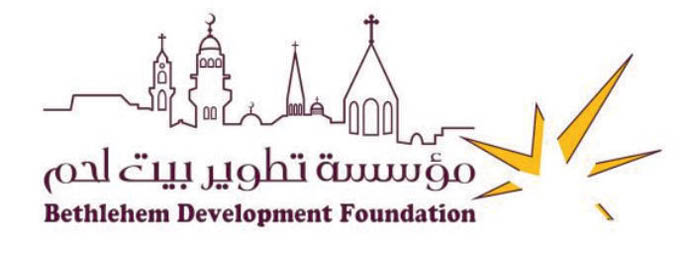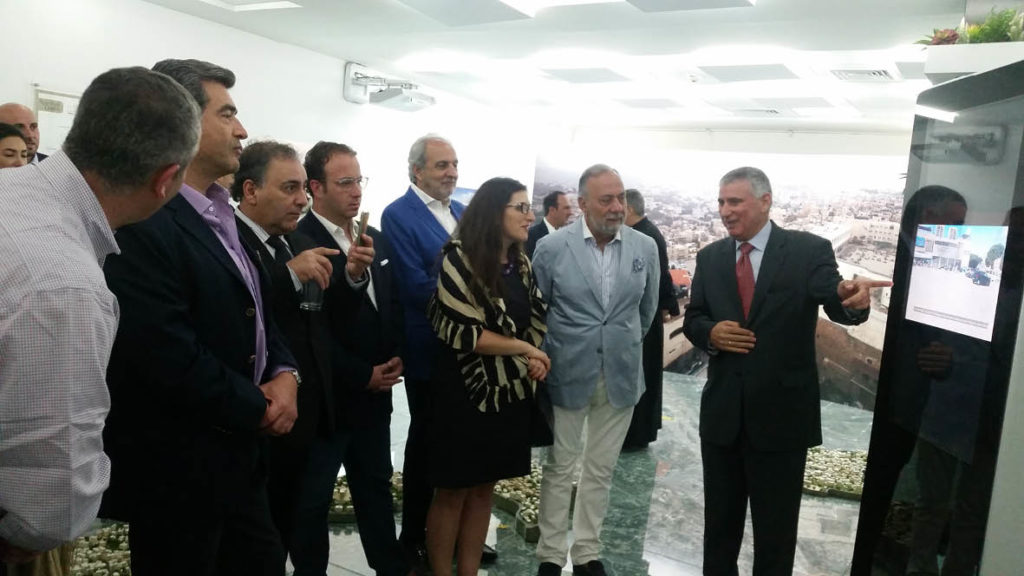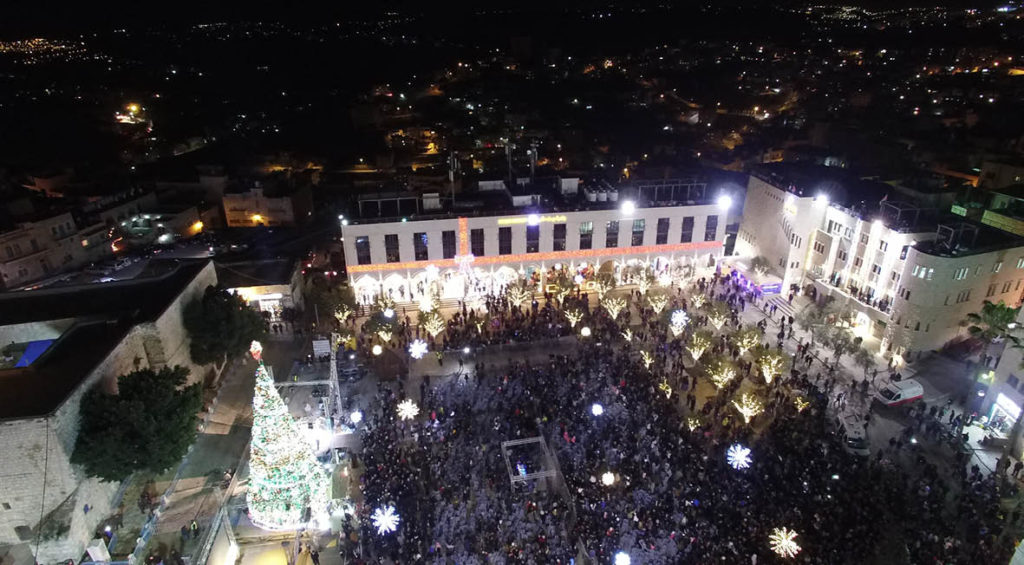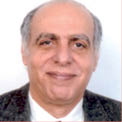
In 2013, the Bethlehem Development Foundation (BDF) was founded by the late Mr. Said T. Khoury with the clear vision and intention to transform the Bethlehem area into a vibrant, international, spiritual destination, worthy of the place that witnessed the birth of Jesus Christ with his message of Love and Peace for all humanity.
Mr. Khoury’s initiative was to help create a sustainable economic and social environment and foster the long-term growth of a fully integrated, prosperous, and harmonious community for all residents of the Bethlehem Governorate. The foundation has indeed helped the governorate achieve outstanding successes, marked by a number of milestones in various fields.
Engaging one of the world’s leading urban planning firms, BDF as a first step conducted a comprehensive urban analysis that underlined the governorate’s situation and delivered a strategic master plan for the regeneration of Bethlehem. Utilizing the expertise of the foundation, socially and economically viable projects were selected to harmoniously restore the holy city. To fulfil this aim and vision and its commitment to the wider community, BDF raised funds and, to a large extent, has accomplished its development plans. The funding has been provided by local, regional, and international public, private, and institutional investors who collectively intervened to revitalize Bethlehem.

It is clear to all concerned that tourism is the best driver for Bethlehem’s regional economic development and employment generation, and that the sector can be of great help in efforts towards poverty alleviation. BDF has done its best to follow the principles of sustainable tourism development outlined by the UN World Tourism Organization (UNWTO), which has defined sustainable tourism as an enterprise that achieves a balance between the environmental, economic, and socio-cultural aspects of tourism development so as to guarantee the long-term benefits of recipient communities. According to UNWTO, sustainable tourism should: 1) make optimal use of environmental resources, maintain essential ecosystems, and help conserve biodiversity; 2) respect socio-cultural authenticity, conserve built and living cultural heritage, and contribute to cross-cultural understanding and tolerance; and 3) ensure long-term socio-economic benefits, fairly distributed to all community stakeholders, including stable employment and income-earning opportunities, social services, and poverty alleviation.
This is commonly called the triple bottom line for sustainable development: environmental, economic, and cultural returns on investment. One can also identify a fourth associated benefit of well-managed tourism: public education for both visitors and residents to deepen their understanding of cultures and the rich religious heritage.

As the Israeli occupation forces and their stringent military controls since 1967 have impeded any kind of development in Palestine, heavily targeting Bethlehem, the city has failed to prosper until recently. It used to employ the traditional tourism model where short-term rewards frequently outrank long-term planning; low-margin quantity eclipses high-benefit quality; and success is measured in the sheer number of arrivals rather than benefit per tourist. Without careful planning and management, the negatives in this approach outnumber the positives. The resulting issues transcend overcrowding: Reckless development harms the environment, degrades scenery, and disrupts local culture. Moreover, with traditional tourism, delicate historical, archaeological, and natural sites suffer physical wear and tear and – very importantly – revenues are channeled away from local communities. In a study* conducted a few years ago, it was found that for every tourist dollar spent in Bethlehem, 85 cents reverted back to the Israeli economy. This resulted in a loss of added value for the Palestinian economy and a net gain for the Israeli economy – helping sustain the occupation. To best achieve long-term planning, BDF has worked closely with the various stakeholders involved to help facilitate dialogue among the private and public sectors and other stakeholders, parties that otherwise might never have collaborated or understood how their decisions reverberate down a tourism destination’s long value chain.
Since 2012, BDF has also successfully managed to elevate Christmas to international prominence, using world-renowned decorators and planners and attracting international media. In 2014, the Bethlehem Christmas tree was listed as the number 12 tree worldwide by Fortune 500. In 2015, the Huffington Post listed it as one of the most extravagant and creative Christmas trees in the world.
It cannot be emphasized enough that Bethlehem is a main Palestinian window to the rest of the world. Bethlehem is a well-recognized international brand, and this intervention has helped emphasize the centrality of Bethlehem in the Christmas celebrations worldwide. It has led to growth in international and local tourism, with large numbers of visitors and pilgrims attending the Christmas tree lighting ceremony – tourism that comes to Bethlehem in a period that used to be considered very low season.
As this development targeted the entire community of the Bethlehem region, there is no doubt that these efforts have helped bring about greater appreciation and pride among all Palestinian residents of the area, Christians and Muslims. It has definitely and inordinately, however, given the Christian community a comparative advantage in this development, as historically Bethlehem’s Christians tend to be heavily involved in the various services of the tourism industry, recognized as Bethlehem’s main economic sector. This has somewhat helped stem the emigration of the Christian community.

Since the signing of the Oslo Agreement, there has been tremendous growth in room capacity, with the growth rate still accelerating, as about nine more hotels are expected to open in the near future, with others already in the planning stage. Driving through Bethlehem, one can notice also the growth of the souvenirs sector, as attractive new souvenir shops line the main roads of Bethlehem and Beit Sahour, contributing effectively to the ongoing revitalization of the crafts industry. Furthermore, visitors can enjoy the fruits of the tremendous growth in the food-services sector in Bethlehem, Beit Sahour, and Beit Jala. This has also increased tourism among our own Palestinian community. Visitors come from the surrounding regions, from Jerusalem, and even from the 1948 region to the Bethlehem area on weekends to enjoy not only the rich heritage but also the various specialized restaurants that the cities have to offer.
All these developments and the associated enhanced services have contributed immensely to the economic regeneration and tremendous growth in employment in the Bethlehem region, a part of Palestine that previously had experienced high rates of unemployment among well-educated youth.
Tourism development requires services, and they include features such as access, security, food, housing, transportation, communication, the provision of souvenirs, and more. Service provision, in turn, requires qualified personnel, such as tour guides, chefs, drivers, transportation companies, street vendors, and an efficient, reliable police force. To help meet the challenge of providing part of these needed human resources, Bethlehem University has stepped forward and is investing in tourism education and training to the tune of US$ 30 million by purchasing three iconic buildings in Bethlehem known as the Mount David property. In its strategic plan, the university has decided to dedicate this largest expansion and development in years to its smallest department, the Department of Tourism Education and Hospitality. Two of these buildings are slated to become a 95-room training hotel and restaurant, while the third is dedicated to cultural education and development. Work is now in progress on the site.
In two direct activities, BDF has contributed to helping stem Christian emigration from Bethlehem. Firstly, BDF has actively participated in the Diaspora Convention, now being held yearly in Bethlehem in an effort to reconnect members of the diaspora community who have their roots in the Bethlehem region with the city of their origin. Many of these are Christian Palestinians.
Secondly, BDF’s most important current activity is its effort to assist the ongoing fundraising for the renovation of the historic Church of the Nativity. This ongoing, very much needed restoration is lifting spirits in the biblical town of Bethlehem, especially now, at Christmastime. Visitors can view the church’s ancient mosaics and columns that have been restored to their original glory for the first time in 500 years. City officials hope that the restoration of the traditional birthplace of Jesus will boost tourism, enhance the weak economy of the Israeli-occupied West Bank, and perhaps even help slow the decades-long drain of the Christian population from the land where their faith was born. “Christians are leaving the Holy Land due to the lack of peace and to escape economic hardship. We are struggling to keep them in their homeland,” says Bethlehem’s mayor, Anton Salman. “It is our hope that by generating employment through tourism development, we can entice many to remain,” he explains.
A tourism product must be promoted, even if that is done “only” by word of mouth. Visiting our city and telling others of the beautiful sights, hospitable services, and great experiences the city has to offer will certainly help greatly in the promotion of Bethlehem as a tourism destination. Day-tourists and visitors are invited not only to stop at the church and go to a souvenir shop but to extend their visit and opt to stay in one of Bethlehem’s hotels to enjoy the great variety of experiences that Bethlehem and the surrounding towns, villages, and areas have to offer.
*The study was conducted by the Higher Council for the Arab Tourism Industry with support from GIZ, the German development agency.


